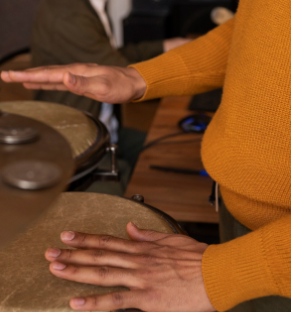Have you ever heard a sound that feels like it came from the stars? That’s the magic of the handpan. Sometimes called a handpan drum, this unique instrument creates soothing, melodic tones that seem to float in the air.
Whether you are a musician or a beginner, this instrument is easy to fall in love with. No complicated sheet music needed. Just touch, listen, and explore. In this guide, we will cover everything you need to know — from what a handpan is, to how to choose your first one, and how to start playing.
What Is a Handpan?
A handpan is a steel, dome-shaped musical instrument that produces soft, melodic tones when struck with the hands. It’s often called a hang drum or hang instrument, although those terms originally referred to the first model made by PANArt in Switzerland in the early 2000s. Today, “handpan’ is the more accurate term for the many similar instruments that followed.
Around a central dome known as the “ding,” it emits warm, resonant notes in a round pattern. Without any formal music training, players may produce lovely melodies and rhythms since each area is tuned to a specific note.
The instrument is fully acoustic — no wires, electricity, or complex setups required. Just your hands and a bit of creativity. The handpan produces a dreamy, soulful sound, whether you are playing softly for meditation or exploring with lively rhythms.
There are many makers worldwide offering handpans for sale, each with unique scales and craftsmanship. Choosing the right one depends on your taste, skill level, and budget — but one thing is for sure: once you start playing a handpan, it is hard to stop.
How a Handpan Works – Understanding the Magic Behind the Sound
1. The Structure of a Handpan
Two steel half-shells are adhered to one another to create a hollow, UFO-like handpan. A core note (the “ding”) and multiple surrounding note sections make up the top shell, also known as the tone field. These are adjusted to vibrate at particular frequencies after being meticulously pounded. In order to aid in projection and resonance, the bottom shell frequently includes a hole in it.
2. How Sound Is Produced
A handpan’s steel vibrates when you lightly tap it with your fingers or palms. A distinct, melodic note is produced by tuning each tone field. The handpan’s unique form and design allow it to produce harmonics, which are rich, ethereal tones that ring out with each touch.
3. Playing Without Sticks
Unlike drums, handpans are played entirely with your hands. This allows for soft, expressive playing that makes the instrument feel almost alive. The touch-sensitive nature of the handpan makes it perfect for beginners and professionals alike.
4. Why It’s Ideal for Beginners
The handpan for beginners usually comes with a simple scale — like D minor or Celtic — that prevents wrong notes. That means you can improvise freely and still sound great, even on your first day.
Choosing Your First Handpan
Pick a Scale That Matches Your Mood
Handpans come in many musical scales — some sound happy and bright, while others feel calm or mysterious. For beginners, popular choices like D Kurd, Celtic Minor, or Amara offer a well-balanced and forgiving sound.
Know What to Look for in Quality
Not all handpans are created equal. A well-made instrument should have:
- Clear, resonant notes
- Balanced volume across all tone fields
- A strong, rust-resistant build (usually nitrided steel or stainless steel)
Consider the Material
Most handpans are made of either nitrided steel or stainless steel. Nitrided steel is durable and traditional, while stainless steel often has longer sustain and is more rust-resistant — great if you live in a humid area or want to play outdoors.
Where to Buy One
There are many makers and websites offering handpans for sale, like Cosmos Handpan. Buy from a trusted maker or reseller with clear sound demos and a good reputation. Don’t fall for super-cheap handpans — a low price often means poor sound quality.
How to Play a Handpan
Use Your Hands, Not Sticks
Use your hands and fingers to play the handpan. Light, controlled touches are all it takes. Avoid hitting too hard — the goal is to tap, not slap.
Master the Basic Techniques
Start with these simple techniques:
- Tap the center “ding” for a deep, resonant tone.
- Strike outer notes with the fingertips for melody.
- Damp a note by touching it right after playing to cut the sound short.
- Glide or sweep your fingers for soft transitions.
Learn from the Community
Watch YouTube tutorials, join handpan forums, or follow players on social media. Many handpan artists share free tips and tutorials. It’s a welcoming community, especially for beginners.
Practice Regularly, Stay Relaxed
Playing a handpan is both a musical and meditative experience. The more relaxed you are, the better it sounds. With regular practice, your hands will naturally find the rhythm and voice of the instrument.
Caring for Your Handpan
Proper care keeps your handpan sounding beautiful for years. After each session, wipe it down with a soft, dry cloth to remove oils and moisture. Store it in a padded case and avoid leaving it in direct sunlight, rain, or extreme temperatures. Apply a light coat of rust-preventive oil every few weeks, especially if it is not stainless steel. Never strike it with hard objects or drop it — dents can ruin the tuning. With gentle handling and regular maintenance, your handpan will continue to produce rich, resonant tones every time you play.
Ready to Begin Your Handpan Journey?
Let the soothing sounds of the Cosmos Handpan guide your creativity and calm your mind. Whether you are a total beginner or looking to add a unique instrument to your collection, Cosmos Handpan offers handcrafted quality, rich tones, and beginner-friendly scales that make playing a joy from day one.
Explore the collection of Cosmos Handpans today – and find the perfect sound that speaks to you. Start your musical journey with a handpan that’s made to inspire.











![Ztec100.com: Your Definitive Manual for Tech[2024]](https://reelsmedia.co.uk/wp-content/uploads/2024/09/ztec100.org_-330x220.png)




